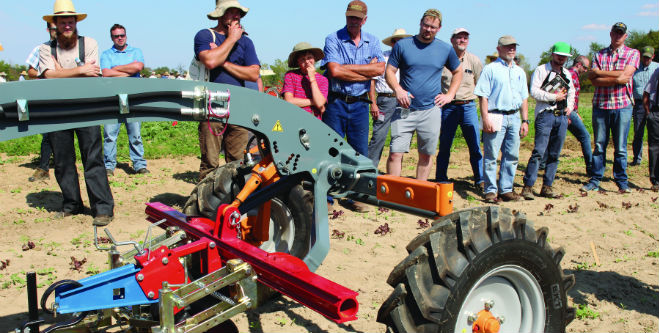
Dec 15, 2017Planned, flexible system key to weed control
Torsion weeders, finger weeders, basket weeders and many more designs were demonstrated at the Midwest Mechanical Weed Control Field Day Sept. 26 at Michigan State University (MSU) in East Lansing. But the focus wasn’t on seeing the machines. It was seeing the technologies as part of a system of planned, precise, constantly adapting, mechanical weed control.
Planning for the event was initiated by a Sustainable Agriculture Research and Education (SARE) grant that sent an MSU faculty member, two MSU graduate students and four Michigan vegetable growers to Europe to study mechanical weed control systems. The SARE program is funded by the USDA’s National Institute of Food and Agriculture.
“European farmers perform mechanical weed control at a high level of precision,” said Sam Hitchcock Tilton, one of the MSU graduate students, and a columnist for Vegetable Growers News.
“We wanted to find out how European growers are using these tools and how we could bring that information back to the U.S.,” said Marisa Benzle, the other MSU graduate student.
“Finger weeders were developed in Michigan in the 1950s,” Hitchcock Tilton said. The technology went to Europe in the 1980s, was redesigned, made with new materials, and adapted to new uses.
“Many of these tools are not new,” said Dan Brainard, associate professor in MSU’s Horticulture Department and faculty member on the European tour. “We’re trying to find the best ways to use them.”
“This equipment isn’t magic,” Benzle said. “Growers in Europe set up their production systems to fit the tools they’re using. Their crop selection, rotation, and planting strategy are focused around the use of the tools.”

The field day brought about 140 vegetable growers from around the country and several equipment manufacturers to East Lansing for equipment displays, field demonstrations and a keynote address by Jean-Paul Courtens, director of farmer training at the Hudson Valley Farm Hub in Hurley, New York.
“At the Farm Hub, we trial new methods that are inherently risky and half jokingly say we can make all of the mistakes on behalf of the area farmers so they don’t have to,” Courtens said.
The Farm Hub is in its fourth year as a non-profit agricultural research and education facility. It covers about 1,300 acres that are planted with corn, soybeans, small grains, cover crops and vegetables.
“There are three ways to mechanically control weeds,” Courtens said. They can be cut off, uprooted or buried.
That sounds almost humorously simplistic, until you remember the Farm Hub is trying to mechanically control weeds inter-row (between the rows) and intra-row (within the crop row) without chemicals and without economically significant crop damage.
For example, suppose you’re in a situation where the weeds must be cut off for effective control, but poor equipment adjustment causes some of the weeds to be uprooted and the root balls left on the surface. A rain could reestablish the weeds.
Weed control at the Farm Hub is a consideration in every step of the production system.
“We use rotation to make sure we don’t have weed populations,” Courtens said.
Tillage is used for specific reasons. In a year of poor control, tillage may be used to bury the weed seed to prevent germination in future years. Shallow cultivation may be preferred when the intent is to control existing weeds without incorporating more weed seed for later germination in the growing season. Keeping weed seed on the surface is important if the goal is weed seed predation.
The Farm Hub uses a number of tools to control cover crops and manage surface residue before preparing the seed bed.
Most vegetables are planted in raised beds that are carefully made with ridging and shaping tools. This gives a controlled traffic system where the beds aren’t compacted and provides easy access to the vegetables.
“We plant in in 50-foot strips because we don’t want people to walk too far with the crop,” Courtens said.
The raised beds also provide drainage during heavy rains. “You want soil moisture to come up to the crop by capillary action,” Courtens said. “Irrigation would help the crop, but would also give an equal advantage to the weeds. I don’t want that. I want to give the vegetable seed the advantage.”
Good seed-soil contact is important to give the vegetables a faster start than the weeds. At the Farm Hub, seed bed preparation requires multiple passes with different tillage tools.
“We try for reduced tillage, but I’m into tillage when creating a seed bed,” Courtens said. “Our beds are incredibly uniform which allows us to do some very precise cultivation. I want to go with that last cultivation only as deep as the vegetable seeds are planted.”
The full range of tine weeders, cultivator shovels, finger weeders and other mechanical weeding tools must be considered for use, and the selected tools may be used in combinations. “Each individual tool may only give you about 30 percent control,” Courtens said, “so you want to combine them for effective control.”
Increasing labor costs, growing for the organic market, and ways to complement chemical weed control are all reasons why vegetable growers are looking at these mechanical control technologies, said MSU’s Brainard.
Torsion weeders, finger weeders and flex tine weeders are three tools MSU researchers have been working with.
Torsion weeders drag just beneath the soil surface and uproot small weeds. “There’s enough flex in them so you can get close to the crop,” Brainard said. Researchers are looking at tractor mounted tools and walk- behind models that operate at slower speeds for smaller operators.
Finger weeders target intra-row weeds where the crop is bigger than the weeds. The weeders work well with transplanted crops like lettuce. They can also be used in crops with larger sized seed, like sweet corn.
Flex tine weeders vertically scrape through the soil and go over the entire soil surface.
Proper timing, using the tools in combination, calibration and constant adjustment are keys to effectively using these tools.
“Flex tine weeders ride just below the soil and the vibration will uproot the small weeds – if you’ve got the depth right,” said MSU’s Hitchcock Tilton. If the tines are running too deep they’ll slide under the roots of small weeds. If they’re running too shallow, they’ll ineffectively bounce along the surface.
“These tools were designed for very specific situations,” said MSU’s Benzle. “Look at how each tool fits into your system.”
— Dean Peterson, VGN correspondent
Fore more on the field day, view these videos:
https://vegetablegrowersnews.com/video/weed-control-field-day-highlights-european-tools/
















